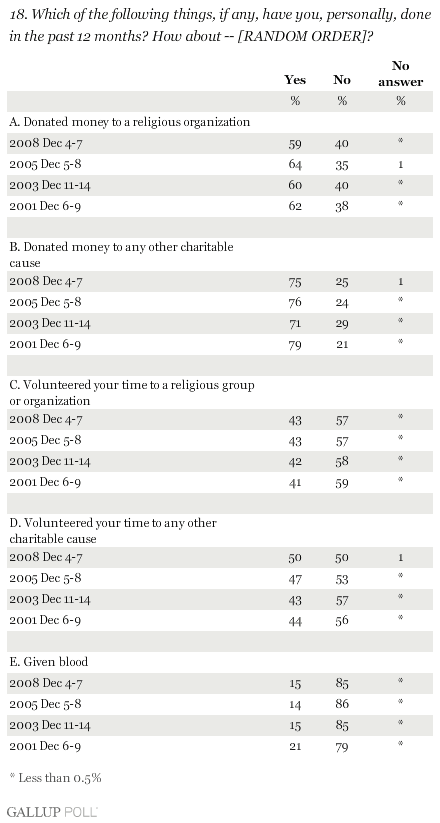PRINCETON, NJ -- Despite the significant downturn in economic conditions in recent years, the percentage of U.S. adults opening their wallets to charitable organizations has hardly diminished. More than four in five Americans continue to say they donated money to a charitable cause or organization in the past 12 months -- now 84%, compared with 87% in December 2005.

The latest results come from Gallup's 2008 Lifestyle Survey, conducted Dec. 4-7. The total number of charitable donors is based on separate measures asking Americans whether they financially support religious organizations and whether they support nonreligious organizations.
Gallup trends on these measures show virtually no change since 2005 in the percentage of Americans making donations to nonreligious causes (76% in 2005 vs. 75% today), but a slight dip, from 64% to 59%, in the percentage supporting religious entities.
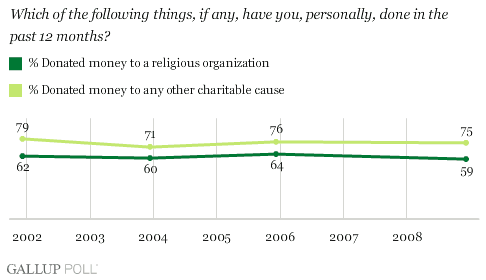
The survey asks only whether respondents donated or not, not how much they gave, and thus cannot quantify the extent to which the amount of charitable giving may, in fact, be down because of the recession.
Time Is Money -- and Harder to Come By
Aside from cash donations, many charities rely heavily on the free labor volunteers provide to staff events, perform office duties, and run fundraisers, among countless other tasks.
According to the Gallup data, fewer Americans part with their time than their money on behalf of charity groups. Sixty-four percent of Americans currently say they have volunteered their time to a charity in the past 12 months, similar to the 62% recorded in 2005.
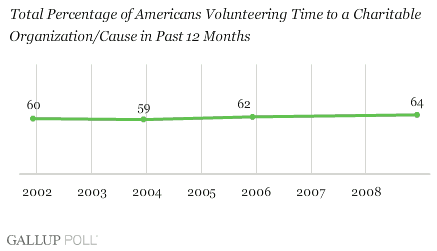
Gallup finds little difference between volunteerism on behalf of religious organizations and that for nonreligious organizations. Exactly half of all Americans in 2008 say they volunteered their time to a nonreligious charitable cause over the past year, while 43% say they volunteered with a religious group or organization, resulting in a modest seven-point gap between the two activities. This contrasts with the 16-point gap in religious vs. nonreligious financial giving: 59% vs. 75%.
Neither type of volunteering has changed appreciably over the past three years, although nonreligious volunteerism is up from 2003, when the figure was 43%.
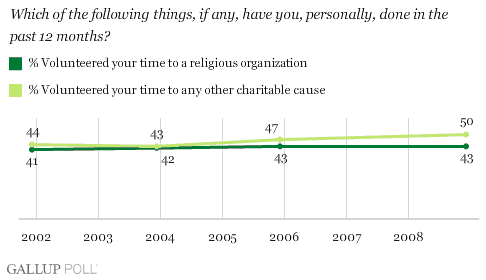
A special form of giving involves donating blood to a medical blood bank, such as the American Red Cross. The rate of Americans' provision of this important service has been stable at around 15% each year in the past several years. It was substantially higher when Gallup first measured it in December 2001, but that was just three months after the Sept. 11 terrorist attacks -- an event that may have raised public awareness of the need for blood donations, or temporarily boosted Americans' willingness to make the effort to give.
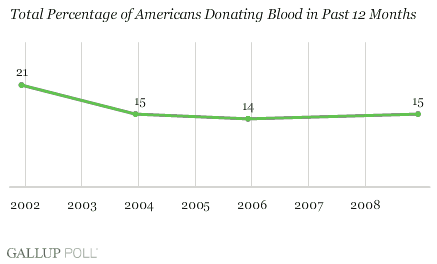
Protestants Lead in Religious Giving
Religious giving and volunteerism are naturally much higher among Americans who proclaim a religious affiliation than among those with no particular affiliation and the nonreligious. Among Christians, the prevalence of financial donors and volunteers to religious organizations is higher among Protestants than among Catholics.
By contrast, there is no difference among Protestants, Catholics, and the nonreligious in the percentage of each saying they contributed money to a nonreligious charity over the past year. There is also no appreciable difference in the percentages donating blood. (The number of respondents falling into other religious categories is too small to analyze.)

Other Findings
-
The 2008 rates of giving and volunteering are similar for men and women in all areas except giving blood. Men are nearly twice as likely as women to say they gave blood in the last year, 19% vs. 11%, a finding consistent with the 2005 poll.
-
Members of upper-income households are much more likely than those in lower-income households to say they donated money to religious and nonreligious causes in the past year, but they are also more likely to have donated their time.
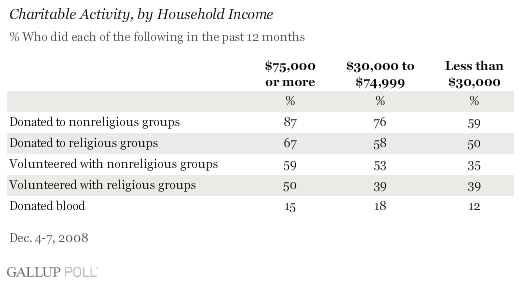
-
Charitable activity tends to be at its highest among Americans aged 30 and older, compared to those aged 18 to 29. In the case of financial donations to religious organizations, those 50 and older are the most active.
-
The generational pattern for donating blood is sharply different, with 18- to 29-year-olds being the most active, and participation dropping significantly among older groups.
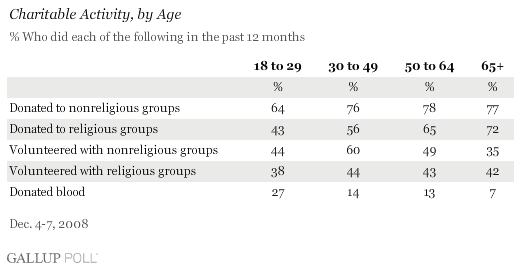
Bottom Line
Charitable giving is a way of life for Americans, most of whom (75%) have provided financial support to a nonreligious charity over the past year. Additionally, more than half (59%) have donated money to a religious organization -- quite likely their own church or other house of worship.
The fact that the nation has been in recession for the past year may have cut into the amount of money Americans are able to contribute (the survey does not record the dollar value of donations); however, it has not had much impact on the total pool of givers. The percentage of Americans donating money to nonreligious charities is as high today as it was in 2005, and the percentage giving to religious groups is down only slightly.
Survey Methods
Results are based on telephone interviews with 1,009 national adults, aged 18 and older, conducted Dec. 4-7, 2008. For results based on the total sample of national adults, one can say with 95% confidence that the maximum margin of sampling error is ±3 percentage points.
Interviews are conducted with respondents on land-line telephones (for respondents with a land-line telephone) and cellular phones (for respondents who are cell-phone only).
In addition to sampling error, question wording and practical difficulties in conducting surveys can introduce error or bias into the findings of public opinion polls.
